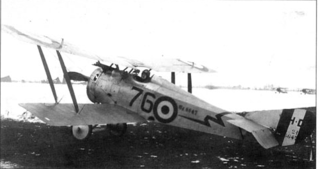
The Italian Corpo Aeronautico Militare was formed as part of the Regio Esercito on 7 January 1915, incorporating the Aviators Flights Battalion (airplanes), the Specialists Battalion (airships) and the Ballonists Battalion. Prior to World War I, Italy had pioneered military aviation in the Italo-Turkish War during 1911–1912. Its army also contained one of the world's foremost theorists about the future of military aviation, Giulio Douhet; Douhet also had a practical side, as he was largely responsible for the development of Italy's Caproni bombers starting in 1913. Italy also had the advantage of a delayed entry into World War I, not starting the fight until 24 May 1915, but took no advantage of it so far as aviation was concerned.

Sottotenente Michele Allasia was a World War I fighter ace credited with five aerial victories.
Sottotenente de Vascello Umberto Calvello was a World War I fighter ace credited with five victories.

Amedeo Mecozzi was an Italian fighter ace of World War I, a general of the Italian Regia Aeronautica and a military theorist credited as the founding father of the "Attack air force" doctrine, which made him a strong opponent to general Giulio Douhet's theories.

Sergente Maggiore Aldo Bocchese was a World War I flying ace credited with six aerial victories.
Sergente MaggioreAntonio Chiri was a World War I flying ace credited with six confirmed and seven unconfirmed aerial victories.

Sergente Cesare Magistrini began his lengthy aviation career as a World War I flying ace credited with six confirmed and four unconfirmed aerial victories.
MarescialloGuido Nardini (1881-1928) was a World War I flying ace credited with six aerial victories.

Tenente Giorgio Pessi was a World War I flying ace born in Austria-Hungary who chose to fly for Italy. He was credited with six aerial victories.
Sergente Romolo Ticconi was a World War I flying ace credited with six aerial victories.

TenenteMario Fucini was a World War I flying ace who claimed credit for 13 aerial victories during the war; seven of these were confirmed in 1919.

Tenente di VascelloOrazio Pierozzi (1884–1919) was a World War I flying ace credited with seven aerial victories.
TenenteLuigi Olivari was a World War I flying ace who claimed 19 aerial victories. His Spad VII stalled into a fatal crash on 13 October 1917. Posthumously, he was awarded credit for eight aerial victories.
TenenteCarlo Francesco Lombardi known as Francis was a World War I flying ace credited with eight aerial victories. Postwar, he was active in his family's rice refinery, as well as in record breaking flights. He formed the AVIA aviation company in 1938.

Tenente colonnelloAlvaro Leonardi was a World War I Sottotenente from Italy and a flying ace credited with eight aerial victories.
Capitano Antonio Reali was an Italian World War I flying ace credited with eleven confirmed aerial victories, and 22 unconfirmed victories. He served in the Regia Aeronautica Reserves from 1923 to about 1940.
Flaminio Avet was a World War I flying ace credited with eight aerial victories. Although born in Nice, France, he served in the Italian military as Italy entered World War I. After a transfer from Lancers to aviation, he trained as a pilot. He began his aerial combat career on 27 November 1918, and would stake a dozen victory claims, eight of which would be verified. He ended the war having won the Silver Medal for Military Valor three times. He returned to Nice postwar, and died there on 21 August 1928.

71a Squadriglia of the Corpo Aeronautico Militare was one of the original fighter squadrons of the Italian military. Founded on 30 January 1916 to fight in World War I, the squadron served until war's end. It flew almost 3,000 combat sorties in defense of Italy at a cost of six pilots killed, scored 17 victories, and produced two aces from its ranks.
77a Squadriglia was one of the first Italian fighter squadrons. After its founding on 31 May 1916, it began flying combat in July 1916, and would operate until the end of World War I. It was one of the squadrons drawn into late 1917's Battle of Caporetto, and forced to retreat after the Italian defeat. By the time the Austro-Hungarians sued for peace, 77a Squadriglia could count some 50 aerial victories scored in about 250 victories.

78a Squadriglia was one of the original Italian fighter squadrons of World War I, serving in combat from 29 June 1916 to 3 November 1918. They flew 4,770 combat missions and were credited with 88 aerial victories.











